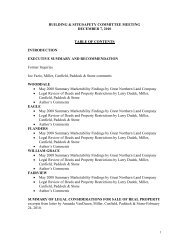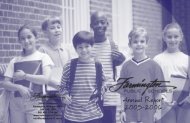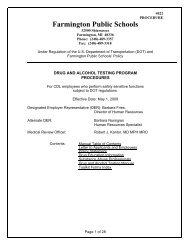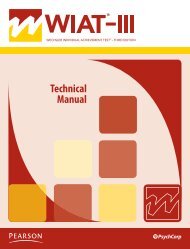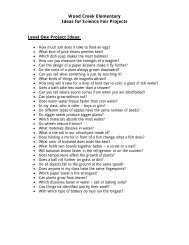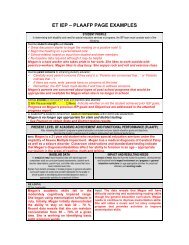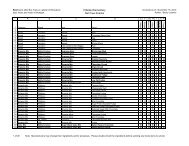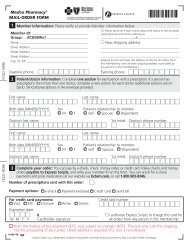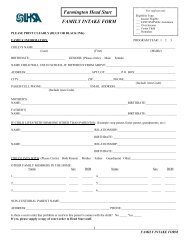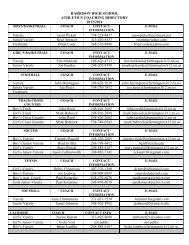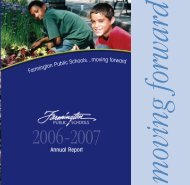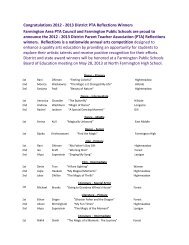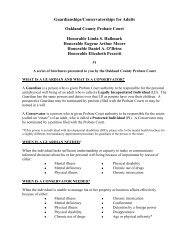Head Lice - Farmington Public Schools
Head Lice - Farmington Public Schools
Head Lice - Farmington Public Schools
Create successful ePaper yourself
Turn your PDF publications into a flip-book with our unique Google optimized e-Paper software.
<strong>Head</strong> <strong>Lice</strong><br />
*Pediculosis<br />
capitis (head lice): are tiny wingless parasitic insects that live on the scalp and<br />
hair of their human hosts, they survive by feeding on human blood<br />
*<strong>Head</strong> <strong>Lice</strong> do NOT spread disease and are not a serious medical condition<br />
*Each year approximately 6-126<br />
million children between the ages of 3 and 12 years of age<br />
are infested with head lice<br />
*About one in every 100 U.S. elementary school children will be infested with head lice
Signs and Symptoms of <strong>Head</strong> <strong>Lice</strong><br />
‣ *<strong>Lice</strong> are tiny wingless insects about the size of a<br />
sesame seed (they do not jump, fly, or swim-but are<br />
good at crawling!)<br />
‣ “Nits” or lice eggs are tiny whitish ovals attached or<br />
“glued” to the hair shaft about ¼ inch from the scalp<br />
(often confused with dandruff or hair casts)<br />
‣ <strong>Lice</strong> can be found anywhere on the scalp but primarily<br />
around the ears and at the back of the neck.<br />
‣ Most common symptom is itching of the head caused by<br />
an allergic reaction to the louse saliva, there may also be<br />
redness or sores caused by the scratching<br />
‣ Often there are not symptoms at all
‣ Sponsored Link
How is <strong>Head</strong> <strong>Lice</strong> Spread<br />
‣ <strong>Lice</strong> are “equal opportunity” parasites.<br />
‣ They infest all socioeconomic groups, races, genders, and ages but b<br />
are more common in children due to their close contact with each<br />
other<br />
‣ Transmission from one individual to another occurs primarily through<br />
head to head contact ***<br />
‣ Although rare, lice can be spread through the sharing of personal<br />
items such as hats, scarves, helmets, brushes, combs or pillows<br />
‣ Infestation can occur throughout the year, although a peak is<br />
generally seen during the summer months and back to school time<br />
periods<br />
‣ <strong>Lice</strong> are not a sign of poor hygiene and they do not transmit disease<br />
‣ If someone in your child’s s class is reported to have lice, don’t t panic!<br />
This doesn’t t automatically mean your child will get it…..it<br />
..it’s s much<br />
easier for your child to get a cold, flu, pink eye, strep throat, , etc.
How do I prevent head lice?<br />
‣ Children should be taught to avoid head to head contact<br />
‣ Teach children not to share combs, brushes, hair<br />
ornaments, hats, caps, scarves, headsets or any other<br />
personal headgear<br />
‣ Do not try on other people’s s hats (even in they<br />
department store)<br />
‣ Teach children to hang coats separately-placing placing hats<br />
and scarves inside the coat/jacket sleeve<br />
‣ Shared headgear (ie(<br />
ie; ; helmets) should be cleaned and<br />
disinfected with Lysol or rubbing alcohol before each use<br />
‣ Regular head checks! (check weekly)
My child’s s been diagnosed with<br />
head lice, what do I do now?<br />
‣ Treatment:<br />
• Over the Counter products (OTC)<br />
• Pyrethrin (RID, Pronto Plus, A200, generics)<br />
• Permethrin (NIX)<br />
• Prescription products<br />
• Benzyl Alcohol Lotion 5% (Ulesfia(<br />
Lotion 5%)<br />
• Malathion (Ovide<br />
Lotion 0.5%)<br />
• Lindane (Lindane<br />
Shampoo)<br />
• Alternative therapies (these have not been proven effective and<br />
are not regulated by the FDA)<br />
• Mayonnaise, essential oil, food oils, vinigar, , etc<br />
• Nit picking (hair combing) with a fine toothed comb is often used<br />
to remove the nits (eggs) from the hair….This takes time and<br />
patience!!
‣ Treating the home environment<br />
• Wash items your child had contact with in the past two days<br />
such as: towels, sheets, pajamas, clothes, coats, hats, and<br />
similar items (us hot soapy water) and/or dry on high heat for at a<br />
least 30 minutes.<br />
• Vacuum floors, carpets, mattress, and furniture<br />
• Wash combs, brushes, hats and other hair accessories in hot<br />
soapy water to remove any lice or nits, and do not share with<br />
others.<br />
• Items that cannot be washed may be stored in a tightly sealed<br />
garbage bag for 2 weeks or may be placed in a freezer or<br />
outdoors (if below freezing) for 24 hours<br />
• Live in the environment (not on the head) usually die within 24<br />
hours.
Treatment Challenges<br />
‣ Improper use of treatment (overuse/underuse)<br />
• Can result in resistance<br />
• Treatment failure<br />
• Safety issues<br />
• Misdiagnosis: results in unnecessary treatment<br />
• Failure to treat
School Policy<br />
‣ Student suspected of having head lice during school<br />
• Student may return to class but restricted from activities involving<br />
ving<br />
close contact (*students with symptoms generally have had lice<br />
for a number of weeks…..a few more hours doesn’t t make any<br />
difference and the emotional/psychological harm is much<br />
greater)<br />
• Parent will be notified by phone as well as by writen letter<br />
• Letter to be sent home to notify classmate’s s parents asking them<br />
to check all of their children for head lice<br />
• <strong>Public</strong> Health fact sheet sent home from the health department<br />
to assist parents.
‣ Student with suspected case of head lice returns<br />
to school<br />
• Student and Parent must return to school office with<br />
signed confirmation of treatment.<br />
• Designated school personnel will re-examine examine the<br />
student’s s hair:<br />
• Student will be readmitted to school if not live lice are found<br />
• Any student with nits (farther than ¼ inch from scalp) should<br />
return to class<br />
• Parent will be encouraged to continue daily lice checks and<br />
nit removal for the next 2-32<br />
3 weeks<br />
• Periodic checks of the students hair by designated school<br />
personnel will be done over the next few weeks until there<br />
are not further signs of infestation
Our District Policy is Based on<br />
What Information<br />
‣ Recommendation of the Michigan Department of Community Health,<br />
Michigan Education Association, Oakland County Health Department<br />
‣ There recommendations come from:<br />
• American Academy of Pediatrics (Pediatrics, Volume 126, August 2010)<br />
• “A A child should not be restricted from school attendance because of lice, because head<br />
lice have low contagion within classrooms.<br />
• ” International guidelines established in 2007 for the effective control of head lice<br />
infestations stated that no-nit nit policies are unjust and should be discontinued, because<br />
they are based on misinformation rather than objective science.”<br />
• “No child should be allowed to miss valuable school time because of head lice.”<br />
• Harvard School of Community Health (Pollack RJ, Kiszewski A, Spielman A,<br />
“Overdiagnosis<br />
and consequent mismanagement of head lice infestations in<br />
North America) Pediatric Infectious Disease Journal, 2000<br />
• “Because<br />
pediculiases is generally misdiagnosed, and because few symptoms and no<br />
direct infectious processes are know to result from an infestation, we suggest that the<br />
practice of excluding presumably infested children from school is i unwarrented.”
Center for Disease Control and Prevention<br />
“Students diagnosed with live lice do not need to be<br />
sent home early from school; they can go home at<br />
the end of the day, treated, and return to class after<br />
appropriate treatment”<br />
National Association of School Nurses<br />
“Data does not support school exclusion for nits<br />
because no disease process is associated with<br />
head lice, schools are not advised to exclude students when<br />
nits remain after appropriate treatment, although further<br />
monitoring for signs of re-infestation is appropriate<br />
International Journal of Dermatology 2006 (<strong>Head</strong> louse infestations: the “no nit”<br />
policy and its consequences)<br />
“Children presumed to be infested with lice should not be immediately excluded<br />
from their school…”<br />
“No child should lose valuable school time because of head lice.”



